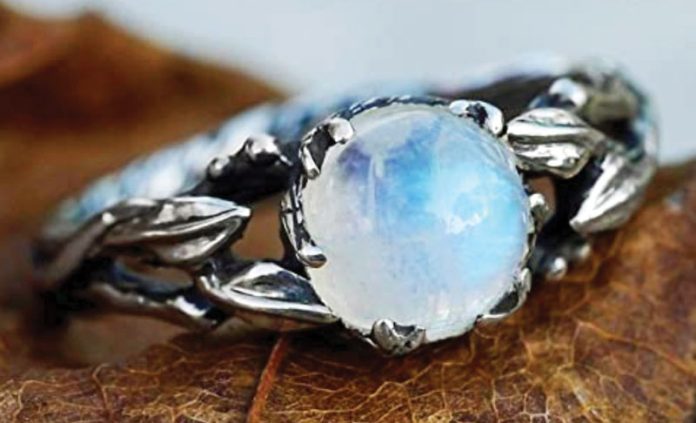
What is moonstone? Moonstone is one of three birthstones by month associated with June, along with pearl and alexandrite. It was adopted as the state gem of Florida in 1970 in commemoration of the moon landing and the history-making steps made by Neil Armstrong. Moonstone has been surrounded by myth throughout time.
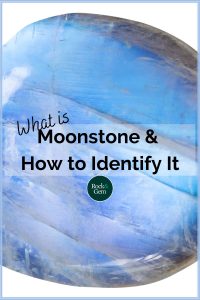
What is moonstone has meant different things to different cultures through time. Greek, Roman, Hindu, and Asian mythology glorified moonstones and often linked them with various moon gods and goddesses. Many ancient cultures believed the stone to be made from moonbeams or formed from moonlight, giving the stone its stunning luster. It’s a popular wedding gift, considered a lucky talisman, and thought to bring the wearer wisdom and the gift of clairvoyance. The moonstone may or may not be magical, but it’s definitely memorable.
What Is Moonstone?
Despite certain misconceptions, moonstones don’t glow under the light of the full moon or glow at night like the moon. These stones shine much better under bright light and put off a luminescent glow reminiscent of the moon.
The play of light on moonstones appears mystical, but the scientific term is adularescence. It’s an optical phenomenon caused by the light shimmering below the stone’s surface and in between its microscopic layers of feldspar.
Moonstones are usually cut into a smooth, rounded cabochon to maximize their shimmering effect.
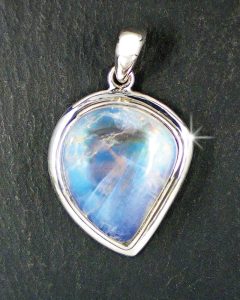
“Moonstone doesn’t glow under the moonlight and for sure, doesn’t glow at night,” confirmed John Chocholacek. “Moonstone was named so because of the incredible blue sheen on the mineral’s surface, which resembles enigmatic moonlight. Moonstone effect is better observed under the sun or another strong light source.”
Chocholacek’s fascination with stones began when he was just a little boy, growing up in Slovakia in Central Europe. He liked taking them home then and not much has changed now that he’s an adult. Chocholacek has been rockhounding in Slovakia, the Czech Republic, Iran, and all around the U.S.
He likes to share his vast experience and knowledge with rockhounds through his website HowToFindRocks.com.
While Chocholacek has become an expert in his own right, he gets help with some scientific aspects of rocks from Olena Rybnikova (www.linkedin.com/in/olena-rybnikova-a6a0501aa). Rybnikova is a gemologist with a Master of Science degree in Mineralogy, Geochemistry, and Petrography from Taras Shevchenko National University of Kyiv, Ukraine. She’s currently working on her Ph.D. in Europe and writing her dissertation on beryllium minerals. Rybnikova is an Applied Jewelry Professional certified by the Gemological Institute of America and actively popularizes gemstones and gemology.
“Moonstone is a varietal name of any mineral from the feldspar group that shows adularescence, or optical phenomenon where the light appears to billow across a stone,” explained Chocholacek. “Usually, moonstone is represented by orthoclase and albite, intermingled during formation. These fine alternating layers of minerals scatter light rays in many directions, producing the highly praised adularescent phenomenon.”
Besides the common adularescence, Chocholacek said some unique moonstone species might show additional optical effects. These can include chatoyancy (cat’s eye effect) and four-rayed asterism (star-shaped concentration of reflected/refracted light from a gemstone).
“It’s quite extraordinary when one type of gemstone displays two different optical phenomena at once,” he said. “Stars are mostly common for rubies and sapphires. In the case of moonstone, it looks really captivating when a well-defined four-rayed star floats above the gentle body color of the gem. These stones usually originate from Sri Lanka.”
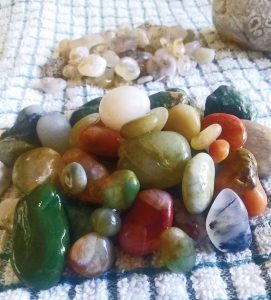
Some Moonstones Aren’t True Moonstones
Although you may see numerous moonstone sites reported, sites verified as valid locations for authentic moonstones aren’t as plentiful in the U.S. It’s essential to know what is moonstone as some stones touted as moonstones aren’t truly moonstones but are similar stones typically confused with moonstones.
For example, the “moonstones” found on Moonstone Beach in Cambria, California, aren’t authentic. Although these moonstones are quite lovely and have similar properties, they’re not moonstones by chemical definition. These stones contain sodium instead of potassium.
“They aren’t truly moonstones,” Chocholacek said. “They are white-colored chalcedony, a variety of microcrystalline quartz. Also, it’s challenging for moonstone, which is an optical phenomenal variety of feldspar, to withstand sea abrasion. Feldspar (6 to 6.5 on the Mohs scale) is softer than quartz (7 on the Mohs scale) and has perfect cleavage in two directions. It rarely forms on beaches. Real moonstones have a blue sheen on the surface, while other stones lack this phenomenon.”
Kind of like the difference between gold and pyrites, faux moonstones are cheaper versions of natural moonstones. Knowing what is moonstone is important but so is recognizing that a good deal may not be a good deal. They’re probably not real if you find moonstones at an incredibly low price. Some fakes aren’t intentional, just natural stones with similar properties mistaken for moonstones like those found on Moonstone Beach. However, some fakes are man-made and may be fraudulently passed off as being the real thing.
Because there are many ways to fake moonstones, be extra cautious if you’re buying them online. One way to test what is moonstone is to place it under a bright light and view it from above. If you notice a bluish or whitish glow, it’s likely the real deal.
Authentic moonstones aren’t perfect and their natural imperfections separate them from fakes. Genuine moonstones have fractures and barely discernable layers in the mineral structure but won’t have round air bubble inclusions. Fake moonstones look too perfect without any fractures or layers.
They also may display round air bubble inclusions when made of opalite, a type of man-made glass.
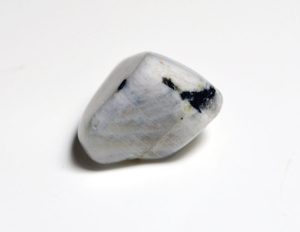
Where to Hunt for Authentic Moonstones
A majority of the most valuable moonstones come from Sri Lanka. Others come from Myanmar, Madagascar, Brazil, Australia, and India. These stones are nearly transparent and have a blue shimmer. However, moonstones may be semi-transparent to opaque and found in a small spectrum of colors, including white, yellow, blue, green, brown, grey, and nearly black hues. There’s also a special and particularly stunning variety called rainbow moonstone that produces several colors simultaneously.
“The rarest and most impressive type of moonstone is the rainbow moonstone. It differs from common moonstones because of its multicolored adularescence, visible on the surface. These stones come from a slightly different mineral – labradorite. Top-quality rainbow moonstones come from Canada, Madagascar, and Zambia,” said Chocholacek.
Rockhounds in the United States that know what is moonstone and would like to find specimens have several potential hunting spots. While beaches are generally a bust, head to the mountains and you may have better luck. You can find authentic moonstones in various places around the U.S. and several other countries for all the globe-trotting rockhounds.
“Moonstone as a phenomenal variety of feldspar is quite rare but at the same time, feldspars are the most widespread minerals in the earth’s crust, as well as some of the most diverse,” he said. “They’re commonly found in igneous rocks, so it’s better to search for moonstone in previously magmatic active regions but not in dry sedimentary rocks. However, don’t forget about secondary alluvial deposits like in Sri Lanka, where moonstones occur in sediments and gravels along with numerous other gemstones.”
Some popular moonstone hunting spots in the U.S. that he suggests include Rabb Canyon Moonstone Pegmatites Gemstone Mine near San Lorenzo, New Mexico; Harris Pegmatite Mine in Hewlett, Virginia; Balsam Mine in Yancey County, North Carolina; and Buford, Forsyth County in Georgia.
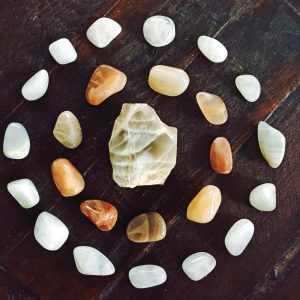
Moonstones Are Fragile
When wondering what is moonstone, remember they’re relatively soft, scratch easily, and may not hold up even to lighter taps as you are searching for them.
Chocholacek said when searching for moonstones, you should use a small chisel instead of big hammers to avoid damaging the stones. Prized for its aesthetic beauty, one of the most popular uses for moonstones is setting them in various pieces of jewelry. Because of the softness of the stone, you must also handle, store and clean moonstone jewelry carefully to ensure you don’t ruin a nice piece.
“In addition to its softness, moonstone cleaves easily. It has two cleavage directions, which means there’s very little stress needed to shatter the stone. For this reason, manufacturers usually set moonstone in earrings, pendants, and pins, rather than in rings that are more likely to receive bumps,” said Chocholacek.
Intense heat and sudden temperature changes also can cause a moonstone to fracture and break. It’s sensitive to harsh chemicals. If you do have a ring featuring a moonstone, remove it before doing housework. Only clean moonstone jewelry with warm soapy water and never place it in steam or ultrasonic cleaners. When storing moonstone jewelry, ensure it’s kept in a cool place and in a pouch or box separate from other pieces of jewelry to prevent scratching or breaking.
Chocholacek fondly remembers his first experience with Moonstone. It was during a geology course field trip while he was completing his university studies.
“It was a huge open-pit mine for labradorite,” he said. “Labradorite, sometimes called rainbow moonstone, is really beautiful. It was raining in the morning that day, so our group entered the still-wet area of labradorite mining and slab production. It was a miracle. Water strengthened the play of color and optical effect on the surface of stones. It looked like Aurora light but from all the rocks around. Unbelievable!”
National & International Valid Moonstone Sites(Per the Hudson Institute of Mineralogy) United States Alabama: Coosa County California: Inyo County Colorado: Gunnison and Mineral counties Connecticut: Fairfield County Georgia: Forsyth and Troup counties Indiana: Marion County Nebraska: Holt County New Mexico: Grant, Sandoval, and Sierra counties New York State and North Carolina: Alexander, Buncombe, Cleveland, Macon, Mitchell, Swain and Yancey counties Pennsylvania: Delaware County Rhode Island: Washington County Tennessee: Sevier County Virginia: Amelia, Bedford, and Hanover counties Wisconsin: Marathon County International Australia: Northern Territory and Queensland Austria: Lower Austria, Styria, Tyrol, Upper Austria South America: Brazil China: Xinjiang Finland: Lapland India: Jharkhand and Tamil Nadu Japan: Toyama Prefecture Mexico: Chihuahua Myanmar: Mandalay Region Norway: Agder and Vestfold og Telemark Poland: Lower Silesian Voivodeship Sri Lanka: North Western Province, Sabaragamuwa Province, and Southern Province |
This story about what is moonstone previously appeared in Rock & Gem magazine. Click here to subscribe. Story by Moira McGhee.















